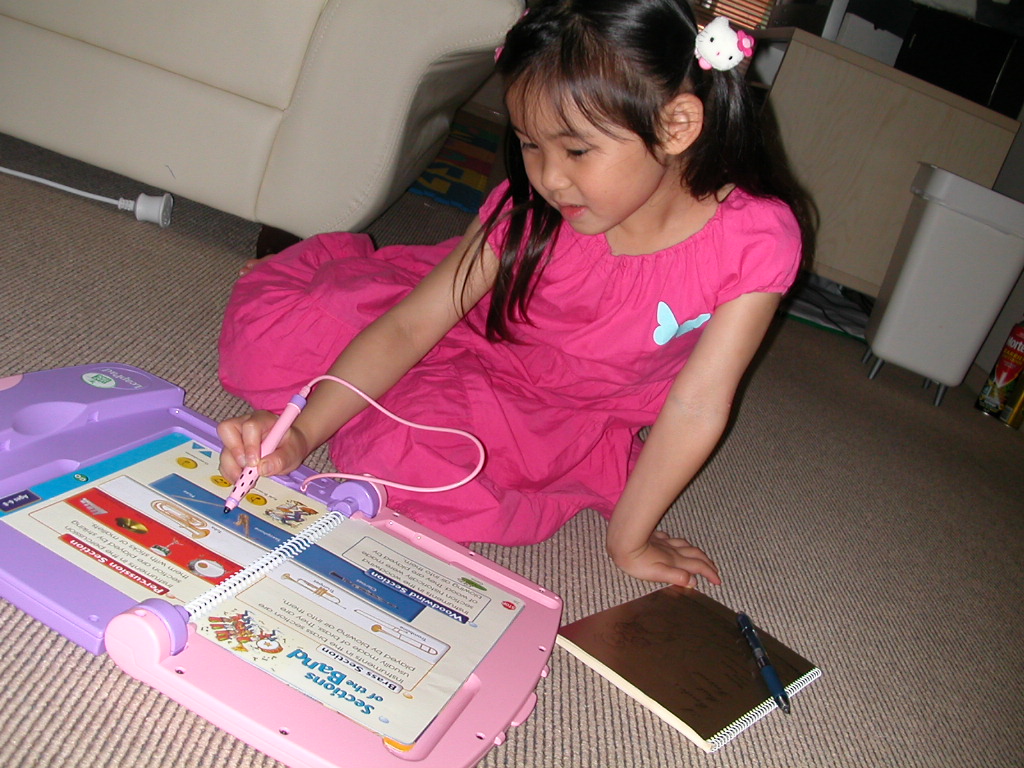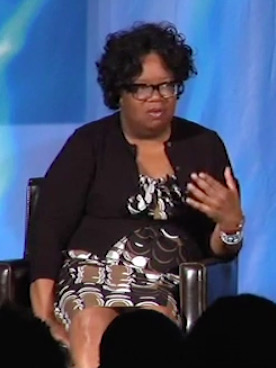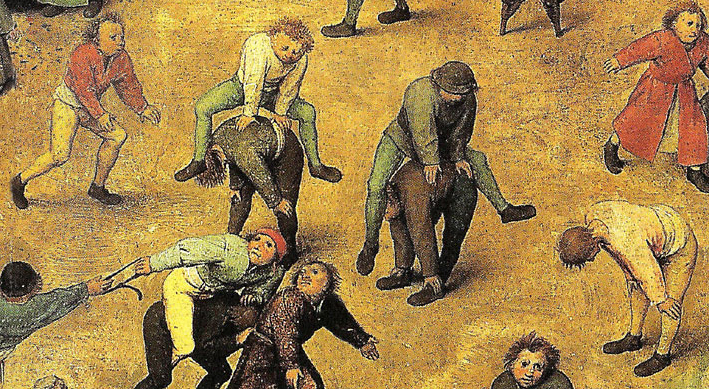|
Leapster 1
The Leapster Learning Game System is an educational handheld game console aimed at 5 to 10-11 year olds (preschool to fourth grade), made by LeapFrog Enterprises. Its games teach the alphabet, phonics, basic math (addition, subtraction, multiplication, division), and art and animal facts to players. Along with a directional pad, the system features a touchscreen with a stylus pen that enables young users to interact directly with the screen. LeapFrog released the Leapster2 handheld device as a successor to the Leapster in July 2008. The Leapster2 is essentially the previous system with an added USB port and SD card slot. These additions give the ability to play a downloaded full game or short game including the ability to log data on gameplay, such as what has been learned by the user or art created by the user. Downloadable games are not for sale. In June 2010, the Leapster Explorer was released, thus ending the original Leapster line. The games released since the Leapster2' ... [...More Info...] [...Related Items...] OR: [Wikipedia] [Google] [Baidu] |
LeapFrog Enterprises
LeapFrog Enterprises, Inc. (commonly known as LeapFrog) is an educational entertainment and electronics company based in Emeryville, California. LeapFrog designs, develops, and markets technology-based learning products and related content for the education of children from infancy through grade school. The company was founded by Michael Wood and Robert Lally in 1994. John Barbour is the chief executive officer of LeapFrog. History Founding: 1990–1997 The history of LeapFrog traces back to the late 1980s when LeapFrog co-founder Michael Wood, an attorney at Cooley LLP, had difficulties teaching his son how to read. He began researching phonics and marketing while continuing as a partner at Cooley. By 1994, Wood had developed the first prototype of what would become Phonics Desk, LeapFrog's first product. The prototype utilized a Texas Instruments chip that was previously used by one of Wood's clients to develop talking greeting cards. Wood solicited feedback on his protot ... [...More Info...] [...Related Items...] OR: [Wikipedia] [Google] [Baidu] |
Subtraction
Subtraction is an arithmetic operation that represents the operation of removing objects from a collection. Subtraction is signified by the minus sign, . For example, in the adjacent picture, there are peaches—meaning 5 peaches with 2 taken away, resulting in a total of 3 peaches. Therefore, the ''difference'' of 5 and 2 is 3; that is, . While primarily associated with natural numbers in arithmetic, subtraction can also represent removing or decreasing physical and abstract quantities using different kinds of objects including negative numbers, fractions, irrational numbers, vectors, decimals, functions, and matrices. Subtraction follows several important patterns. It is anticommutative, meaning that changing the order changes the sign of the answer. It is also not associative, meaning that when one subtracts more than two numbers, the order in which subtraction is performed matters. Because is the additive identity, subtraction of it does not change a number. Subtraction ... [...More Info...] [...Related Items...] OR: [Wikipedia] [Google] [Baidu] |
The Backyardigans
''The Backyardigans'' is a computer-animated musical children's television series created by Janice Burgess. The series was written and recorded at Nickelodeon Animation Studio. It centers on five animal neighbors who imagine themselves on fantastic adventures in their backyard. Each episode is set to a different musical genre and features four songs, composed by Evan Lurie with lyrics by McPaul Smith. The Backyardigans' adventures span many different genres and settings. The show's writers took inspiration from action-adventure movies, and many episodes are parodies of movies. Nickelodeon called the show "a home-grown Nick Jr. property," as "the whole creative team... adbeen part of the Nick Jr. family for years." Creator Janice Burgess had worked as Nick Jr.'s production executive since the mid-1990s. ''The Backyardigans'' originated as a live-action pilot episode titled "Me and My Friends," filmed at Nickelodeon Studios Florida in 1998. The characters were played by full-bod ... [...More Info...] [...Related Items...] OR: [Wikipedia] [Google] [Baidu] |
Animal Genius
''Animal Genius'' is a puzzle video game released for Windows in 2003, the Leapster in 2006, and Nintendo DS in 2007. Jack DeVries, writing for IGN ''IGN'' (formerly ''Imagine Games Network'') is an American video game and entertainment media website operated by IGN Entertainment Inc., a subsidiary of Ziff Davis, Inc. The company's headquarters is located in San Francisco's SoMa distri ..., gave the game a score of 6.5/10, concluding that it is a decent title for young children with an interest in animals. Gameplay ''Animal Genius'' consists of mini-games that test animal smarts, quick thinking and instincts on the quest to win 25 animals that live in five different habitats around the world—rainforest, Arctic, grasslands, ocean, and woodlands. At the start of the game choose a habitat to explore. After choosing a habitat, the player can earn up to five animals for that habitat by playing the mini-games. Each animal is worth a different point value. During the game, there ... [...More Info...] [...Related Items...] OR: [Wikipedia] [Google] [Baidu] |
Musical Menace , the ability to perceive music or to create music
*
{{Music disambiguation ...
Musical is the adjective of music. Musical may also refer to: * Musical theatre, a performance art that combines songs, spoken dialogue, acting and dance * Musical film and television, a genre of film and television that incorporates into the narrative songs sung by the characters * MusicAL, an Albanian television channel * Musical isomorphism, the canonical isomorphism between the tangent and cotangent bundles See also * Lists of musicals * Music (other) * Musica (other) * Musicality Musicality (''music -al -ity'') is "sensitivity to, knowledge of, or talent for music" or "the quality or state of being musical", and is used to refer to specific if vaguely defined qualities in pieces and/or genres of music, such as melodiousnes ... [...More Info...] [...Related Items...] OR: [Wikipedia] [Google] [Baidu] |
1st Grade
First grade (also called Grade One, called ''Year 2'' in England or Primary 2 in Scotland) is the first grade in elementary school and the first school year after kindergarten. Children are usually 6–7 years old in this grade. Examples by region Asia *In Israel, children enter the first grade (''kita aleph'') the year they turn six or seven. *In South Korea, First Grade, known as (''il-hak-nyeon''), begins in March when a child is six or seven years old. *In China, First Grade, known as (''yī nián jí''), begins in September when a child is six years old. *In Japan, First Grade, known as (''i-chi-nen-sei''), begins in April when a child is six years old. *In Singapore, First Grade (or more commonly, "Primary 1"), begins when a child is six years old. Child at least 6 years old on 1 January of a given year gain admission to P1. *In Bahrain, the minimum age for the first grade is seven years old. *In Bangladesh, First Grade (known as ''prothom sreni'') begins in January ... [...More Info...] [...Related Items...] OR: [Wikipedia] [Google] [Baidu] |
Homebrew (video Games)
Homebrew, when applied to video games, refers to games produced by hobbyists for proprietary video game consoles which are not intended to be user-programmable. The official documentation is often only available to licensed developers, and these systems may use storage formats that make distribution difficult, such as ROM cartridges or encrypted CD-ROMs. Many consoles have hardware restrictions to prevent unauthorized development. A non-professional developer for a system intended to be user-programmable, like the Commodore 64, is simply called a ''hobbyist'' (rather than a ''homebrew developer''). Development can use unofficial, community maintained toolchains or official development kits such as Net Yaroze, Linux for PlayStation 2, or Microsoft XNA. Targets for homebrew games are typically those which are no longer commercially relevant or produced, and with lower standards in art quality, such as the Atari 2600, Nintendo Entertainment System, Wii, Nintendo 3DS, Genesis, ... [...More Info...] [...Related Items...] OR: [Wikipedia] [Google] [Baidu] |
LeapFrog
Leapfrog is a children's game in which players vault over each other's stooped backs. History Games of this sort have been called by this name since at least the late sixteenth century. ''''. Accessed 2008-10-21. Rules The first participant rests their hands on knees and bends over, which is called ''giving a back''. The next player places hands on the first's back and leaps over by straddling legs wide apart on each side. On landing he stoops down and a third leaps over the first and second, and the fou ...[...More Info...] [...Related Items...] OR: [Wikipedia] [Google] [Baidu] |
English As A Second Language
English as a second or foreign language is the use of English by speakers with different native languages. Language education for people learning English may be known as English as a second language (ESL), English as a foreign language (EFL), English as an additional language (EAL), English as a New Language (ENL), or English for speakers of other languages (ESOL). The aspect in which ESL is taught is referred to as teaching English as a foreign language (TEFL), teaching English as a second language (TESL) or teaching English to speakers of other languages (TESOL). Technically, TEFL refers to English language teaching in a country where English is not the official language, TESL refers to teaching English to non-native English speakers in a native English-speaking country and TESOL covers both. In practice, however, each of these terms tends to be used more generically across the full field. TEFL is more widely used in the UK and TESL or TESOL in the US. The term "ESL" has ... [...More Info...] [...Related Items...] OR: [Wikipedia] [Google] [Baidu] |
SD Card
Secure Digital, officially abbreviated as SD, is a proprietary non-volatile flash memory card format developed by the SD Association (SDA) for use in portable devices. The standard was introduced in August 1999 by joint efforts between SanDisk, Panasonic (Matsushita) and Toshiba as an improvement over MultiMediaCards (MMCs), and has become the industry standard. The three companies formed SD-3C, LLC, a company that licenses and enforces intellectual property rights associated with SD memory cards and SD host and ancillary products. The companies also formed the SD Association (SDA), a non-profit organization, in January 2000 to promote and create SD Card standards. SDA today has about 1,000 member companies. The SDA uses several trademarked logos owned and licensed by SD-3C to enforce compliance with its specifications and assure users of compatibility. History 1999–2003: Creation In 1999, SanDisk, Panasonic (Matsushita), and Toshiba agreed to develop and market the S ... [...More Info...] [...Related Items...] OR: [Wikipedia] [Google] [Baidu] |
USB Port
Universal Serial Bus (USB) is an industry standard that establishes specifications for cables, connectors and protocols for connection, communication and power supply (interfacing) between computers, peripherals and other computers. A broad variety of USB hardware exists, including 14 different connector types, of which USB-C is the most recent and the only one not currently deprecated. First released in 1996, the USB standards are maintained by the USB Implementers Forum (USB-IF). The four generations of USB are: USB 1.''x'', USB 2.0, USB 3.''x'', and USB4. Overview USB was designed to standardize the connection of peripherals to personal computers, both to communicate with and to supply electric power. It has largely replaced interfaces such as serial ports and parallel ports, and has become commonplace on a wide range of devices. Examples of peripherals that are connected via USB include computer keyboards and mice, video cameras, printers, portable media players, mob ... [...More Info...] [...Related Items...] OR: [Wikipedia] [Google] [Baidu] |
Touchscreen
A touchscreen or touch screen is the assembly of both an input ('touch panel') and output ('display') device. The touch panel is normally layered on the top of an electronic visual display of an information processing system. The display is often an LCD, AMOLED or OLED display while the system is usually used in a laptop, tablet, or smartphone. A user can give input or control the information processing system through simple or multi-touch gestures by touching the screen with a special stylus or one or more fingers. Some touchscreens use ordinary or specially coated gloves to work while others may only work using a special stylus or pen. The user can use the touchscreen to react to what is displayed and, if the software allows, to control how it is displayed; for example, zooming to increase the text size. The touchscreen enables the user to interact directly with what is displayed, rather than using a mouse, touchpad, or other such devices (other than a stylus, which is opti ... [...More Info...] [...Related Items...] OR: [Wikipedia] [Google] [Baidu] |






